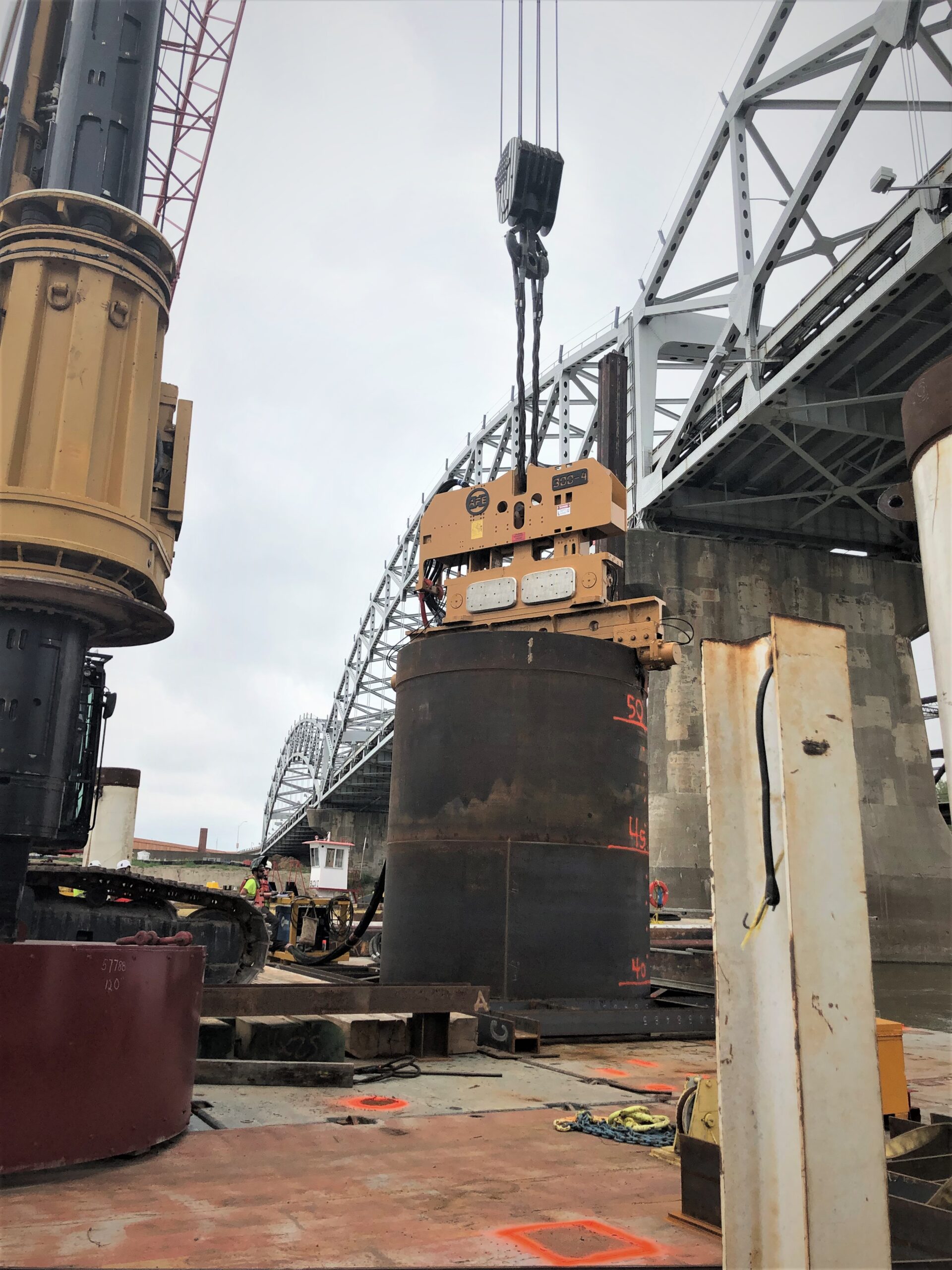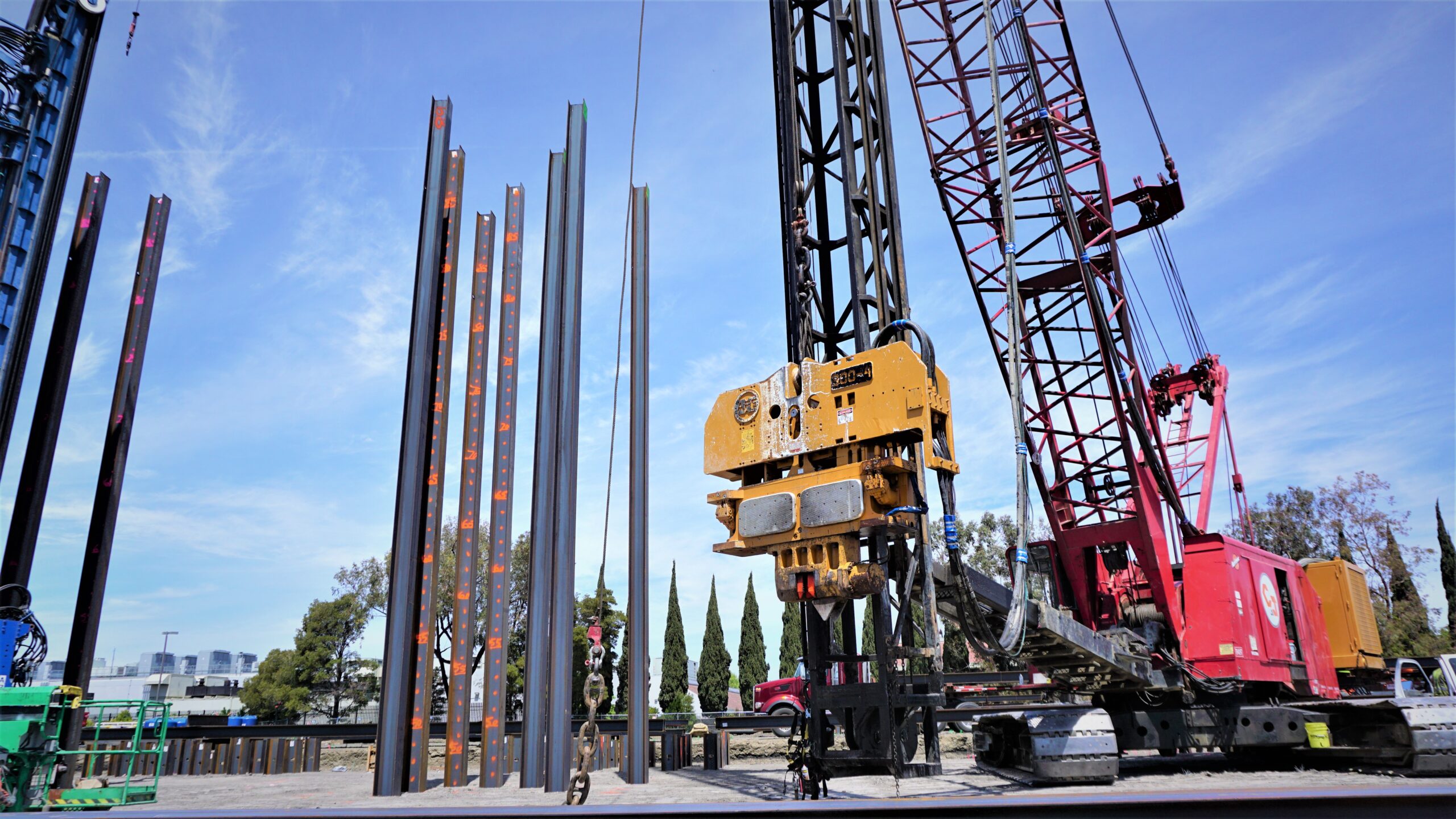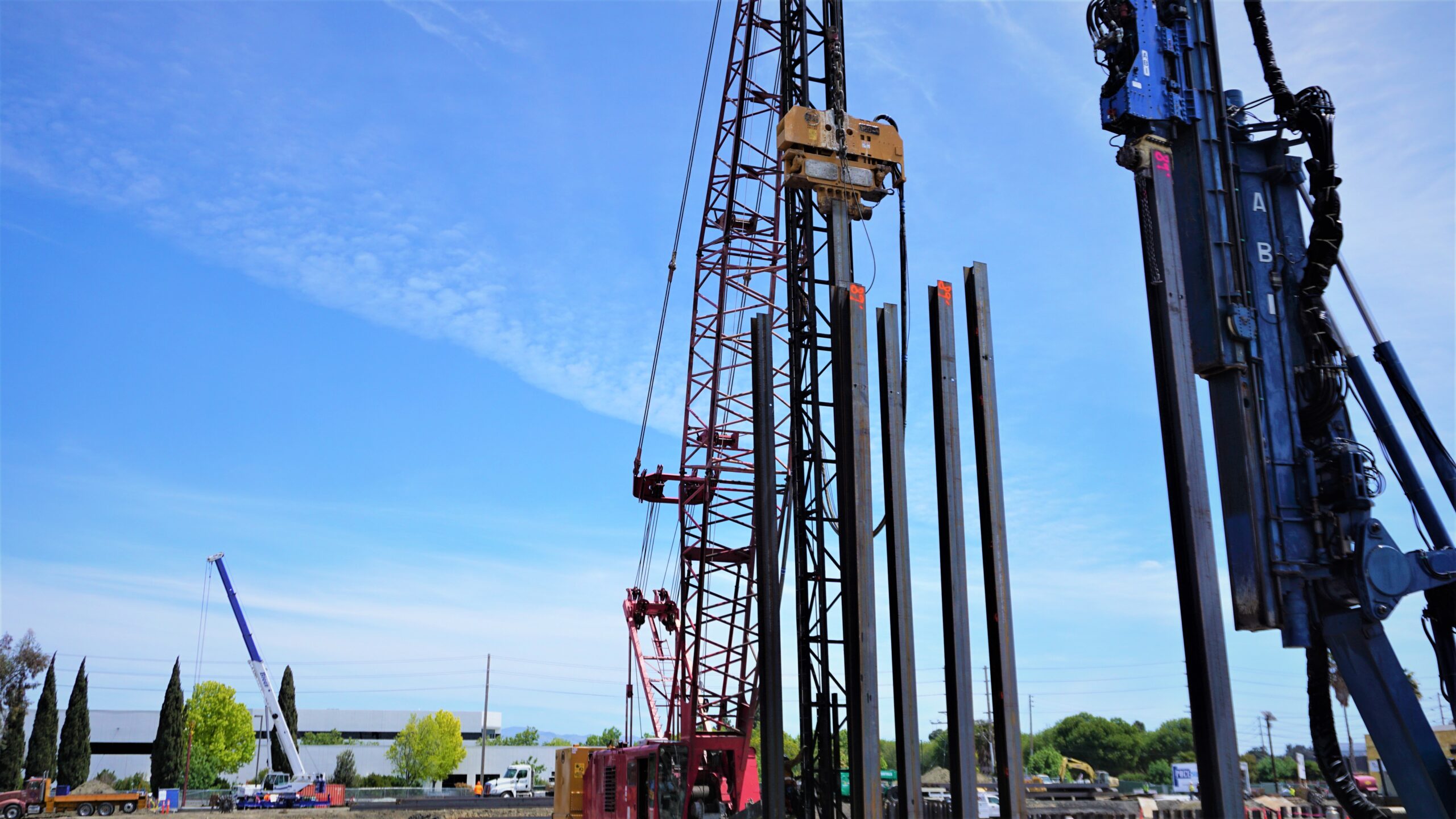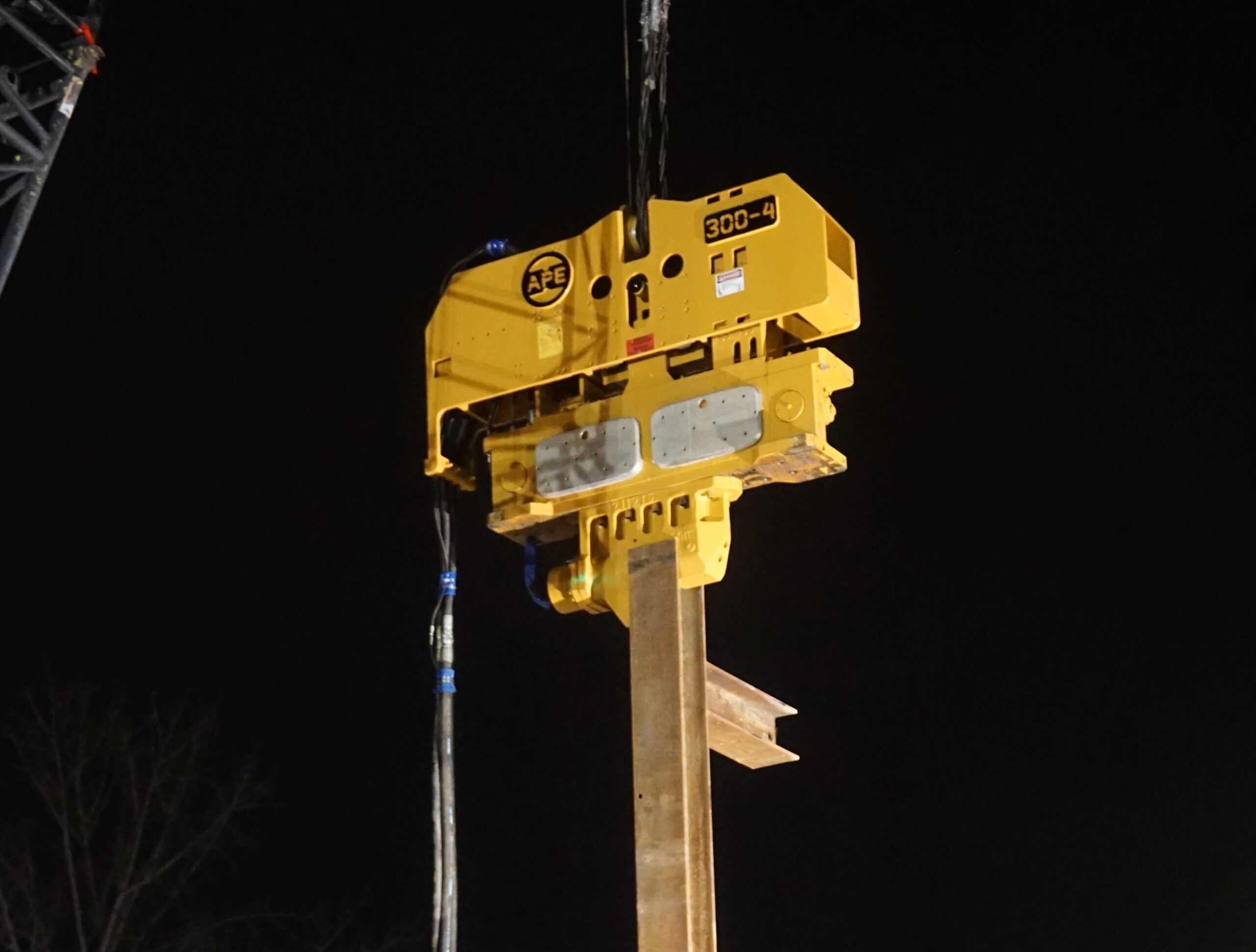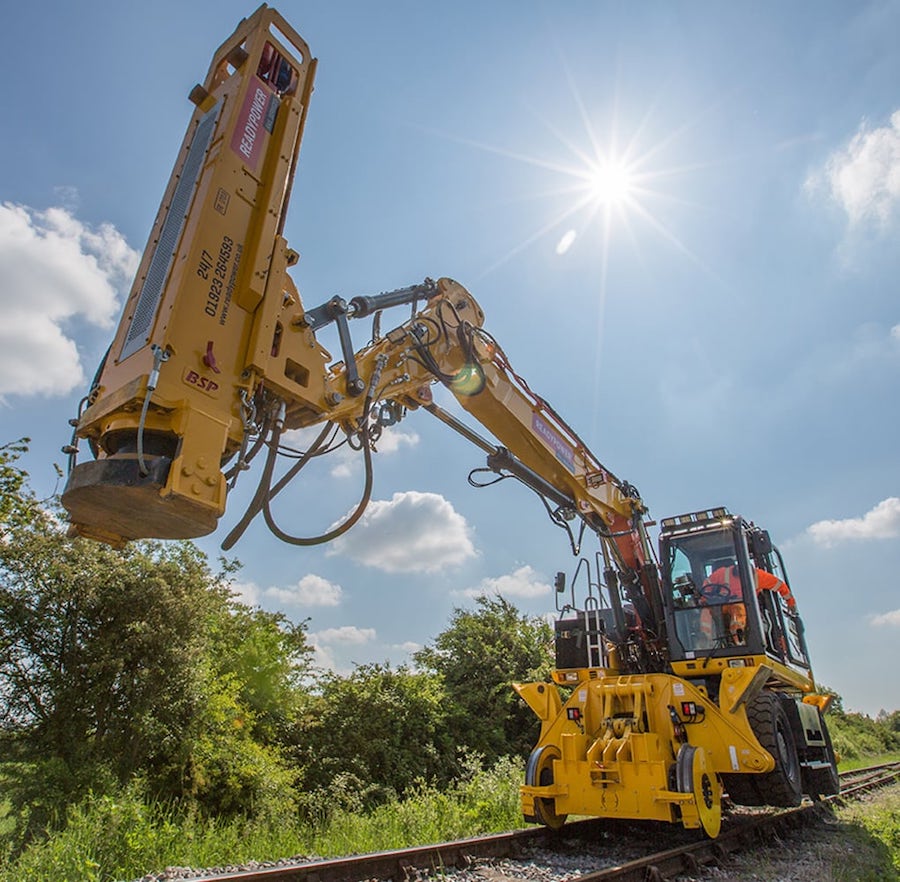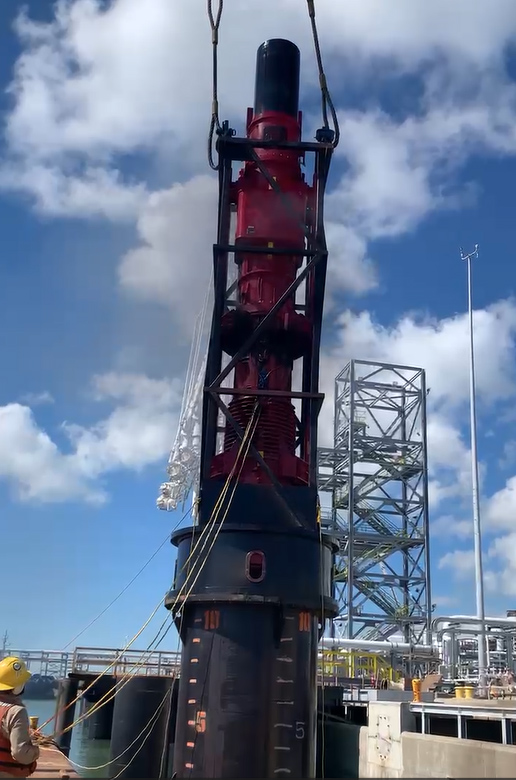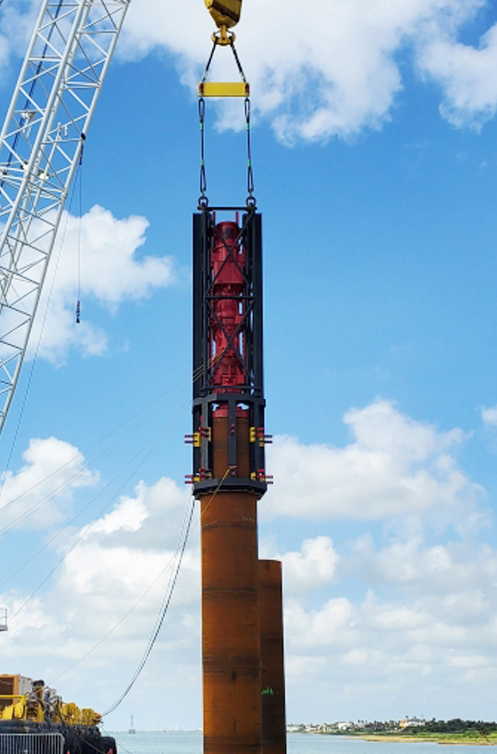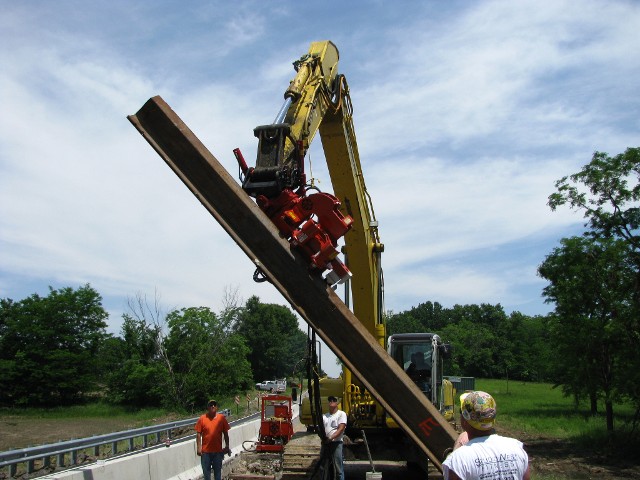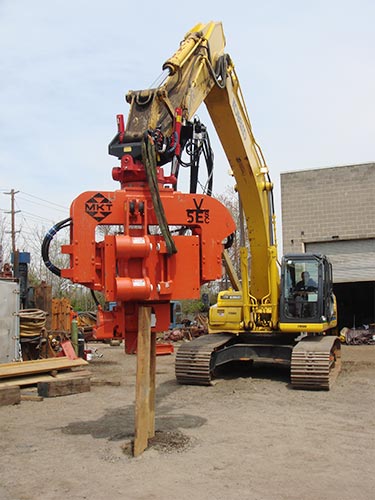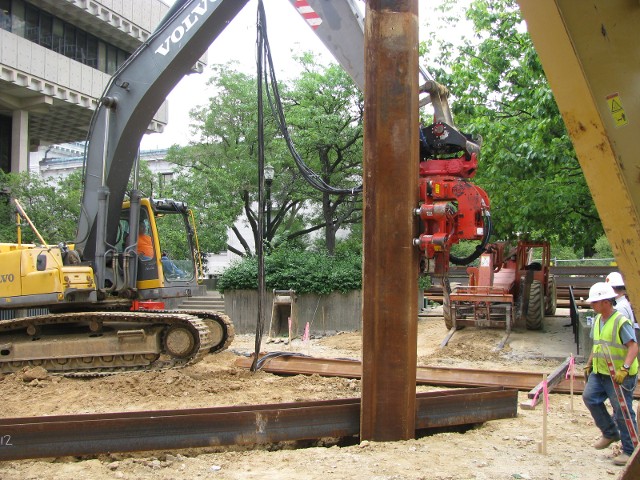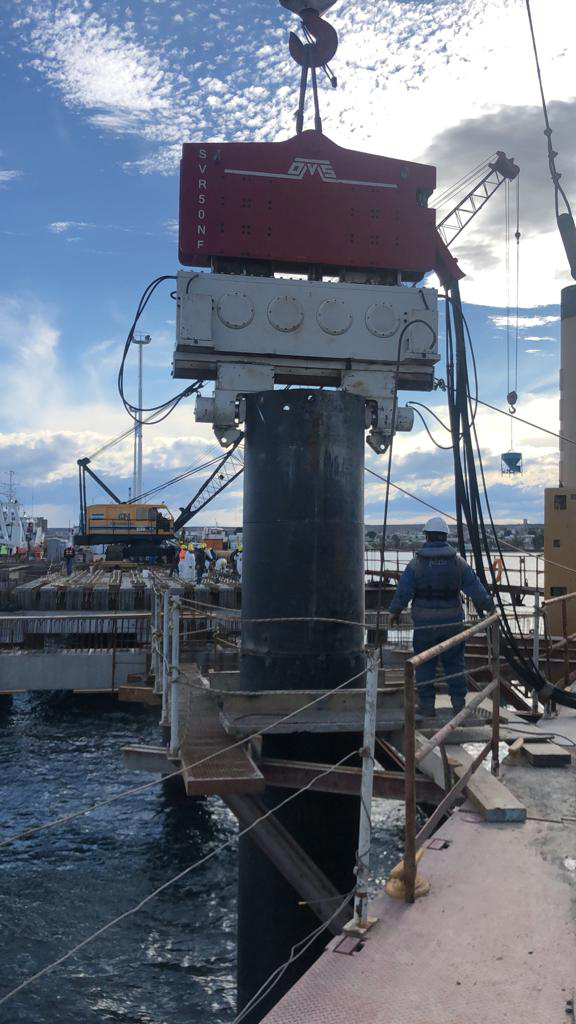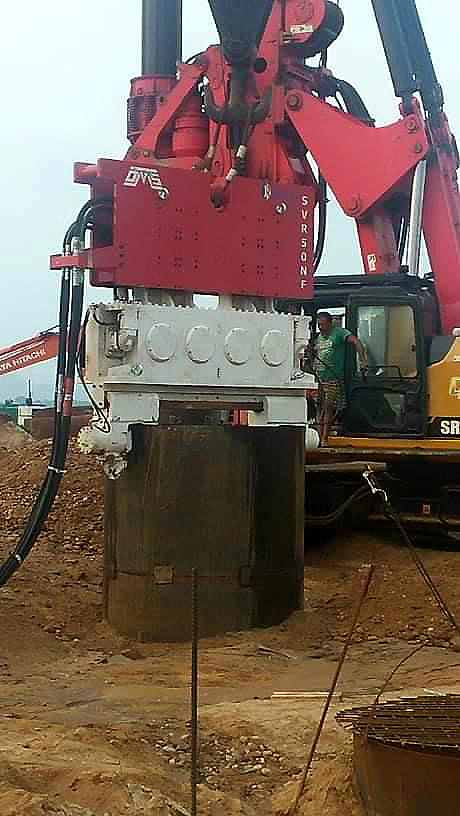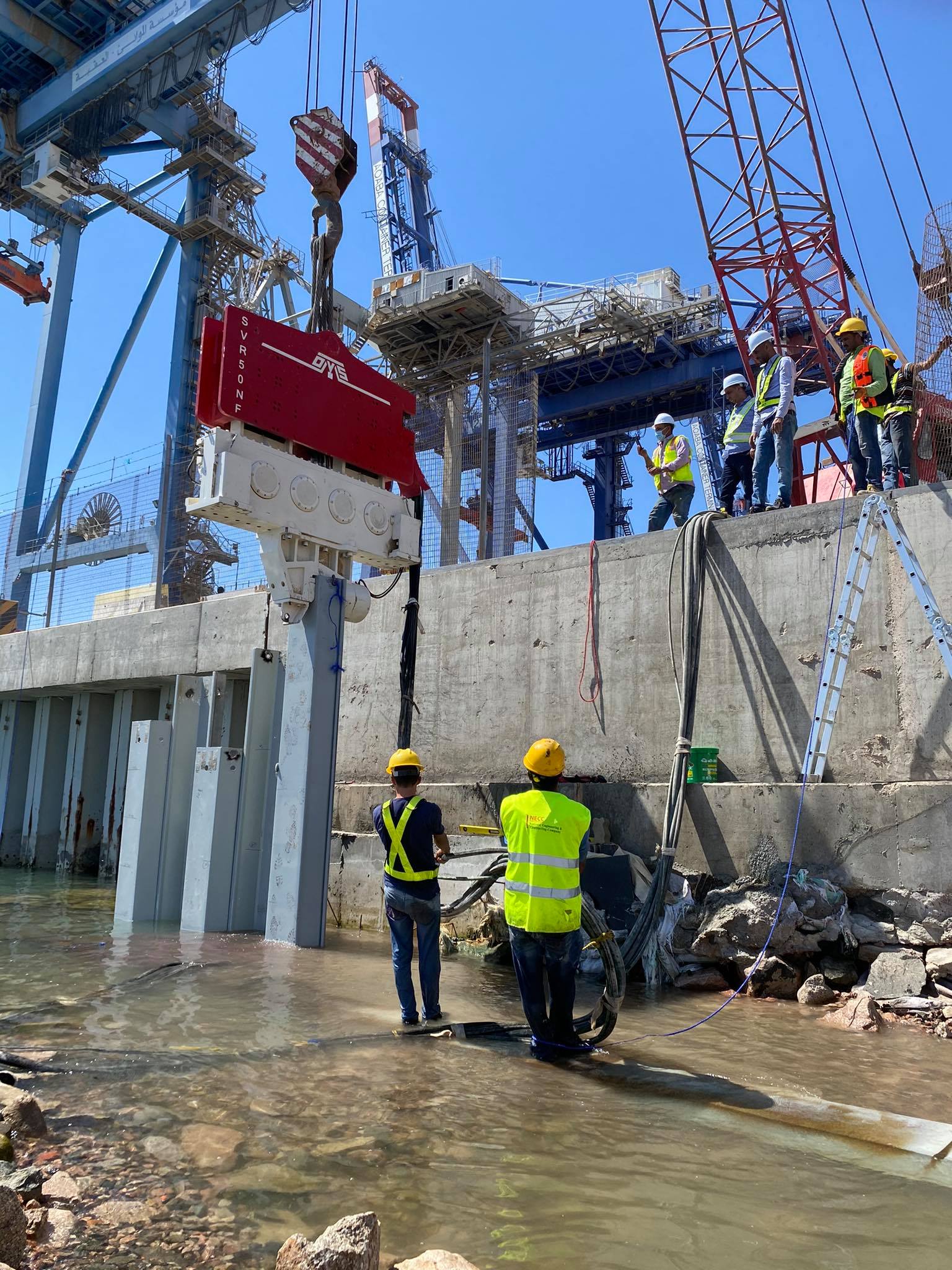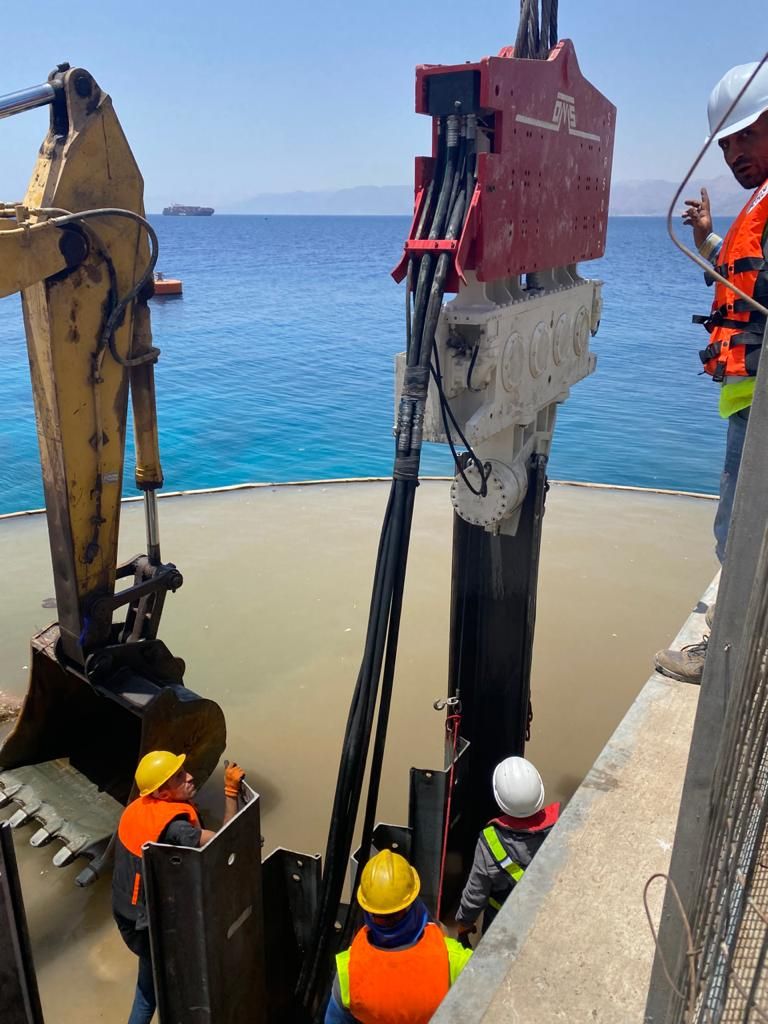| HPSI 500 | Model 300-4 | OMS 50 NF |
|---|---|---|
| GeoQuip Power Systems | American Piledriving Equipment | OMS Pile Driving Equipment |
| More information | More information | More information |
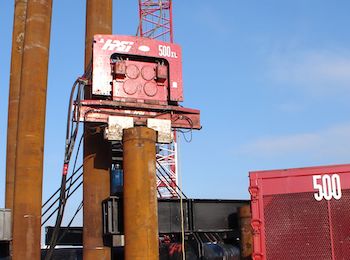 |
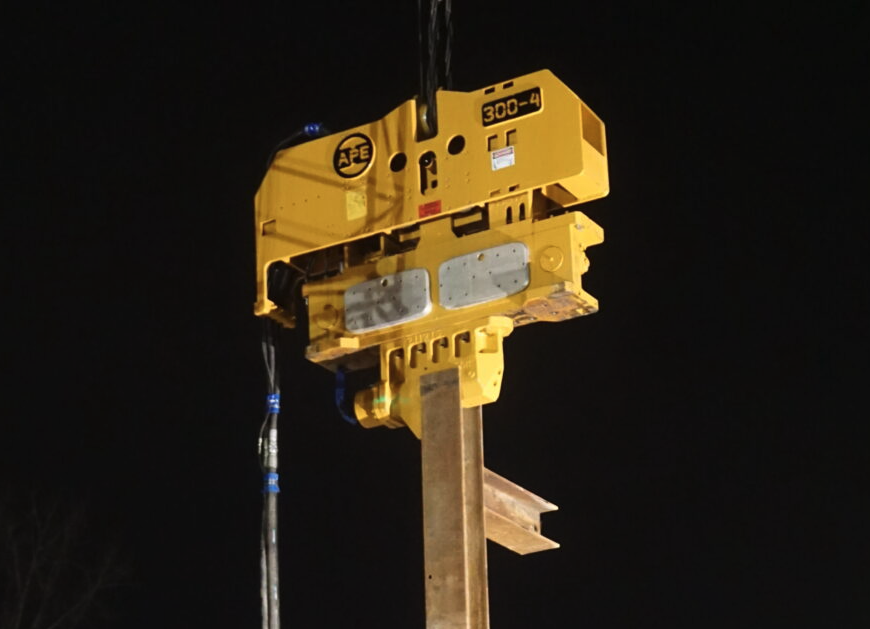 |
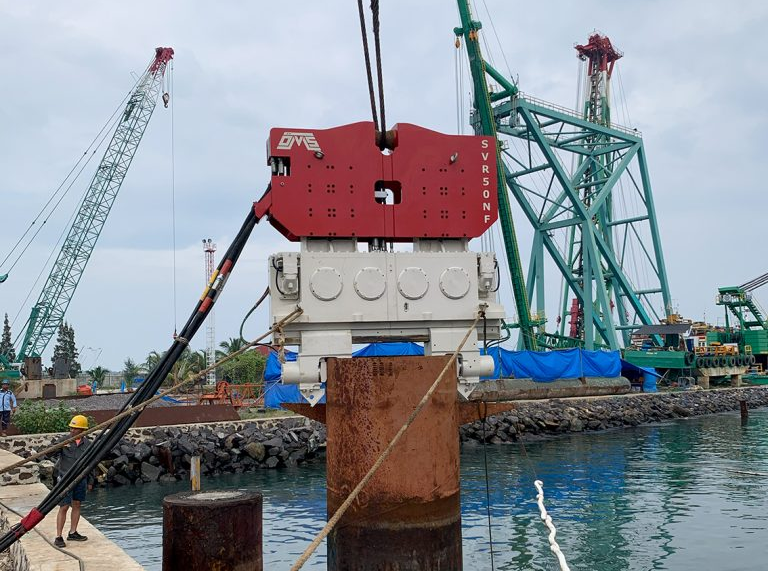 |
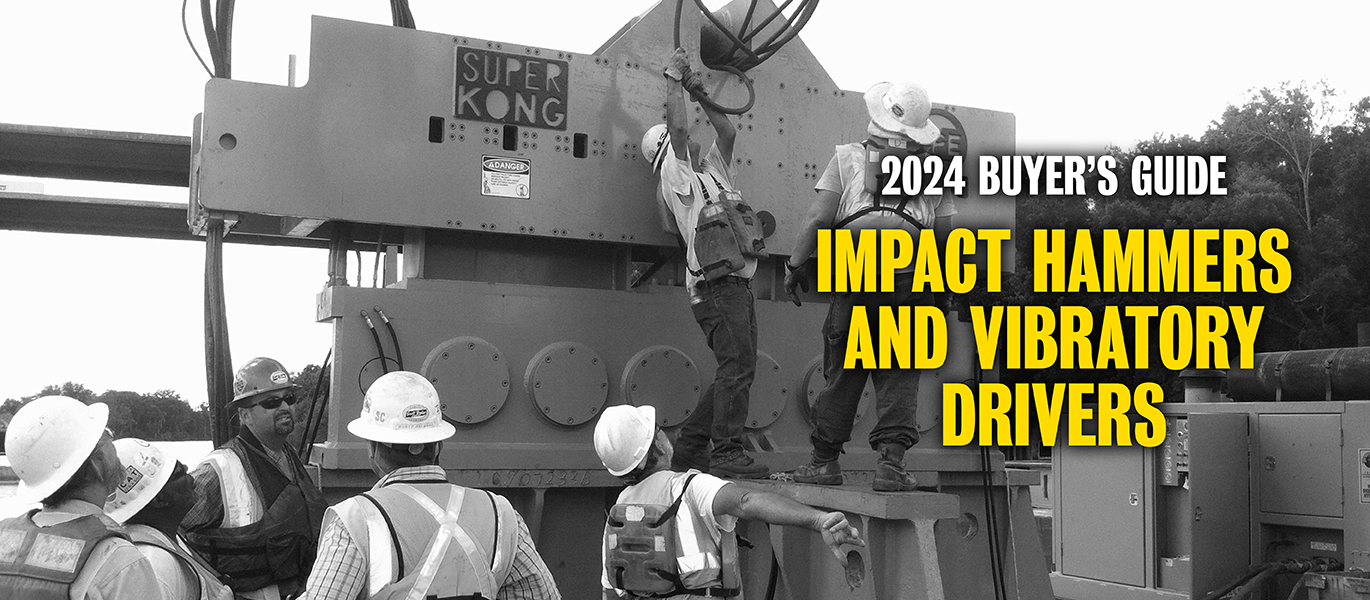
Pile Buck's Top Recommended Pile Hammers
| D280-22 | 36-3000 Air Hammer | V5Esc |
|---|---|---|
| Pileco | Pile Master | MKT Manufacturing |
| More information | More information | More information |
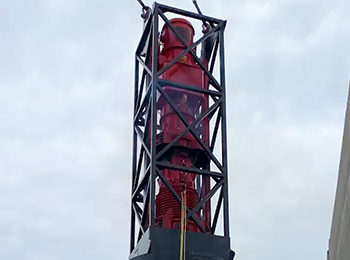 |
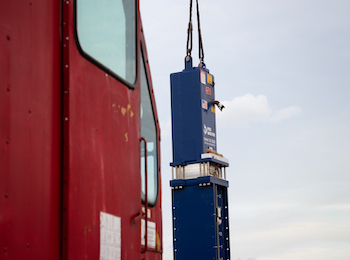 |
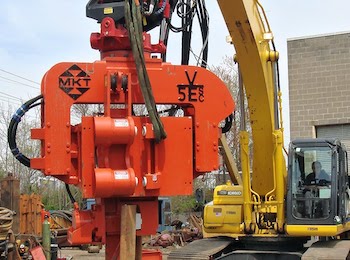 |
Overview of the Driving System
All components of the driving system have some effect on the performance of a hammer and/or how the hammer transfers its energy to a pile.
The driving system consists of:
- The lead, also called the set of leads, sometimes including a brace that allows for the adjustment of the lead angle.
- The hammer cushion, which protects both the hammer and the pile from excessive stress.
- The helmet, which aligns the pile head and hammer.
- The pile cushion. This is only needed on concrete piles. It is typically made of several layers of plywood.
Equipment Selection
Hammer selection is the most important aspect of pile installation. Identify the broadest possible selection of hammers for the job. In some installations only one hammer type may be applicable for the pile-soil combination, while for others several types may be suitable. When it comes to pile driving, a hammer isn’t just a hammer. It’s also a piece of testing equipment. The vertical advance of a pile under a given hammer blow is used as a measure of the pile’s bearing capacity. The hammer’s interaction with the pile-soil system is both modeled before driving (wave equation analysis) and monitored during pile installation (pile driving analyzer).
Evaluation must consider:
- The need to use pile penetration rate as the means to end driving.
- The ability to drive the pile without structural damage or reducing soil capacity.
- The ability to obtain penetration rates within the desired band.
- The realization that some hammer types may cause reduced capacities for identical pile lengths.
Selection of a hammer should consider the anticipated driving resistance, ultimate capacity, pile stresses expected during driving, and soil set-up.
Junttan Pile Driving Rig
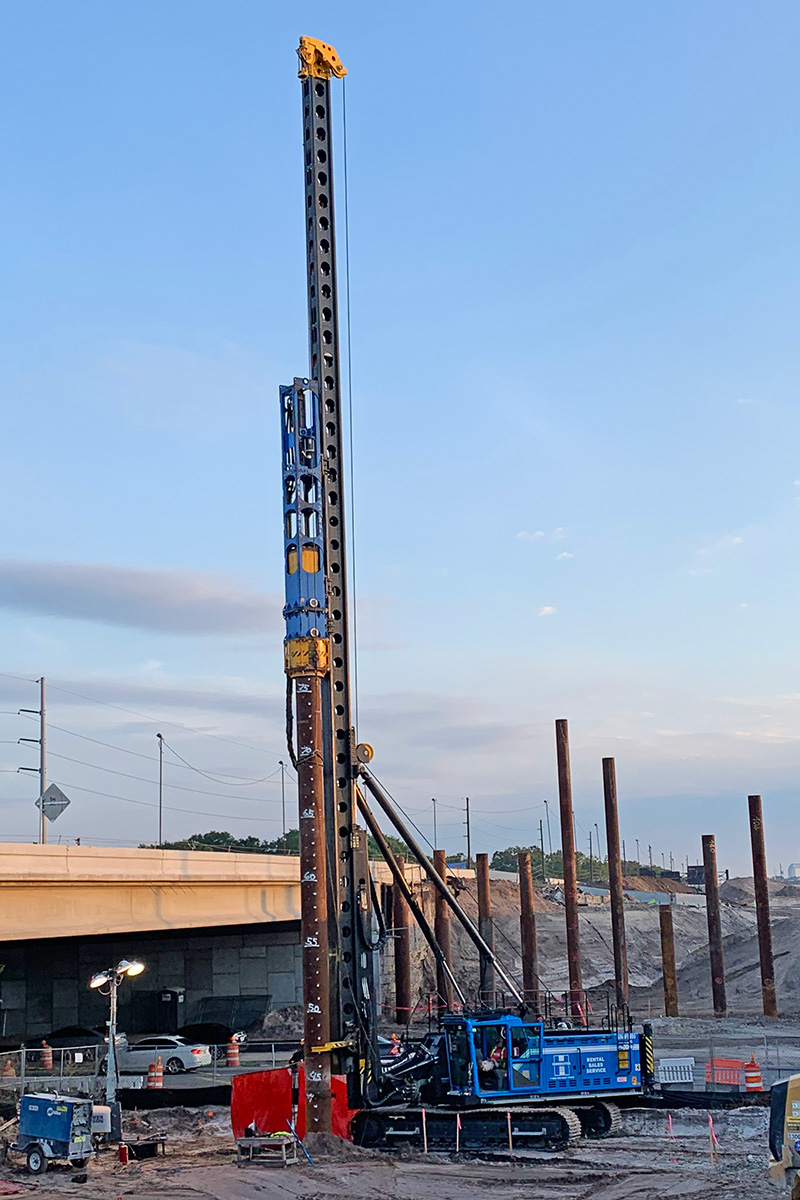
Types of Hammers
Over the years, technology has advanced toward the development of larger and faster hammers. These developments included rams that were raised by ropes through human or horse muscle, those hoisted by steam winches or powered by steam, air, or hydraulic pressure, and finally the diesel hammer. Double acting hammers were developed in order to speed up operations.
Impact Hammers
Impact pile driving hammers consist of a ram and an apparatus that allows the ram to move quickly upwards and then fall onto the driving system and pile. The ram must have a mass and impact velocity that is sufficiently large to move the pile.
A properly functioning hammer strikes the pile in quick succession. It transfers a large portion of the kinetic energy of the ram into the pile. The stroke of a pile- driving hammer is usually between three and ten feet (900 to 3000 mm).
External Combustion Hammers
External combustion hammers burn the fuel that provides the energy for the operation outside of the hammer itself. These hammers have external power sources such as the crane, steam boilers, air compressors, and/or hydraulic power packs. The energy moves the ram upward, and in some hammers, downward as well.
Drop Hammers
The drop hammer is the oldest type of pile driving hammer in existence. The hammer is connected to a cable that is attached to a winch on the crane. The hammer is raised to the desired stroke. The winch has a clutch on it that allows the operator to release the hammer, which falls by its own weight and strikes a pile cap and the pile.
The available energy per blow of a drop hammer is the product of the ram weight times the drop height. Standard ram weights range from 500 to 10,000 lbs (2.5 to 50 kN). Typical drop heights are approximately 4’ (1.2 m). For a given hammer, varying the drop height can vary the energy per blow. Drop hammers are typically used on very small projects and for small piling.
Advantages of Drop Hammers
- Simplicity of operation.
- Ease of mobilization and demobilization.
- Low investment and maintenance costs.
- Drop height can easily be changed.
Single Acting Air/Steam Hammers
Single acting air/steam hammers are essentially drop hammers, except that the hoisting cable is replaced by pressurized air or steam (motive fluid). The ram is usually a short, stocky block of steel that is connected at its top to a piston. It is guided by columns or inside guiding enclosure.
Single acting air/steam units from Vulcan and Menck are commonly used to drive piles offshore.
The operating rate of single acting air/steam hammers range between 35 and 60 blows per minute. This rate is comparable to most other hammer types that lack downward assist.
Advantages of Single Acting Air/Steam Hammers
- Higher rate of blows per minute than drop hammers.
- Relatively consistent operation.
Disadvantages of Single Acting Air/Steam Hammers
- Additional equipment needed (e.g., boiler, compressor, hoses, etc.)
- Relatively heavy hammer that requires higher crane and handling equipment capacities.
Double, Differential and Compound Acting Air/Steam Hammers
The desire to create a hammer that applies blows in rather quick succession for increased productivity led to the development of double acting air/steam hammers. For an increase in blow rate, the stroke was shortened. In order to maintain a comparable energy rating, the ram was accelerated during its down stroke using active pressure.
Advantages of Double, Differential and Compound Acting Air/Steam Hammers
- The speed of operation is twice as fast.
Disadvantages Double, Differential and Compound Acting Air/Steam Hammers
- Energy output is very sensitive to proper valve timing, and to pressure and volume of the motive fluid.
- Each blow is more difficult to inspect and verify.
- The applied hammer energy output is sensitive to soil resistance.
Hydraulic Impact Hammers
A hydraulic hammer incorporates the use of an external energy source to lift the hammer to the top of its stroke. For the single acting hydraulic hammer, the free-falling piston develops the actual energy induced into the pile, much the same power stroke as a drop hammer or a single acting air/steam hammer.
These hammers substitute hydraulic fluid for air or steam, and it is applied to the piston to move the ram. A hydraulic power pack provides the pressurized fluid to operate the hammer. Hydraulic impact hammers can be single acting, double acting, differential acting, or other variations. Most but not all hydraulic hammers employ the use of an electric valve operated with a variable timer. The timer allows for flexible control of the output energy. Others use a purely hydraulic system to control the valve and thus the cycling of the ram. Some are powered using the hydraulic power units on the crane or excavator.
Most hydraulic hammer manufacturers claim high efficiencies for their hammers. Although there are many improvements in hydraulic hammers that enable a more efficient drop, the main reason for the higher efficiencies is that they have some kind of downward assist to equalize the hydraulic flow during the hammer cycle.
Internal Combustion Hammers
These hammers burn the fuel that powers them inside of the hammer itself. The diesel hammers are the only constituent of this class, although other types of fuel are being used.
Single Acting (Open End) Diesel Hammers
An open-end diesel hammer consists of a long slender piston (the ram), which moves inside a cylinder. The cylinder is open at its upper end, thus allowing the ram to partially emerge from the cylinder. Since the ram falls only under gravity, the OED is also called single acting.
There are many manufacturers of open-end diesel hammers throughout the world. The hammer ratings vary from 5 to more than 300 kip-ft with ram sizes between 1 and 35 kips.
Advantages of Single Acting (Open End) Diesel Hammers
- Self-contained unit does not require additional equipment.
- Increasing strokes in hard driving provide increasing energies.
- Low strokes in easy driving protect concrete piles.
- Relatively low ram weight compared to energy (high strokes.)
Disadvantages of Single Acting (Open End) Diesel Hammers
- Stroke dependent on hammer-pile-soil system.
- Relatively low blow rates with high strokes.
- Potential for environmental problems (very dependent upon how hammer is outfitted with fuel and lubricants).
Upon impact, the ram pushes the impact block, hammer cushion, helmet, and pile head rapidly downward, allowing the cylinder to fall under gravity. The impact block separates from the ram within a very short time and the pressure of the combusting air-fuel mixture will cause further separation as the ram is forced upward.
Double Acting (Closed End) Diesel Hammers
A closed end diesel hammer consists of a long slender piston (the ram), which moves inside a cylinder. The cylinder is closed at its upper end, thus causing the ram to compress the air trapped between ram and cylinder top. When the ram falls, it is subject to both gravity and the pressure in the bounce chamber. For this reason, the CED is also called double acting.
There are two prominent manufacturers of closed end diesel hammers distributing their products in North America: Bermingham and MKT Geotechnical systems. The hammer ratings vary from 5 to not more than 80-kip-ft, with ram sizes between 1 and 10 kips. The MKT hammers are built using liquid fuel injection. Bermingham’s closed end models use atomized fuel injection.
Advantages of Double Acting Diesel Hammers
- Self-contained unit does not require additional equipment.
- High blow rate compared to open-end diesels.
Disadvantages of Double Acting Diesel Hammers
- Uplift in hard driving.
- Uncertain energy when combustion prevents ram-anvil impact.
- Stroke is not easily determined.
- Complex maintenance.
APE 180-2 Impact Pile Driver
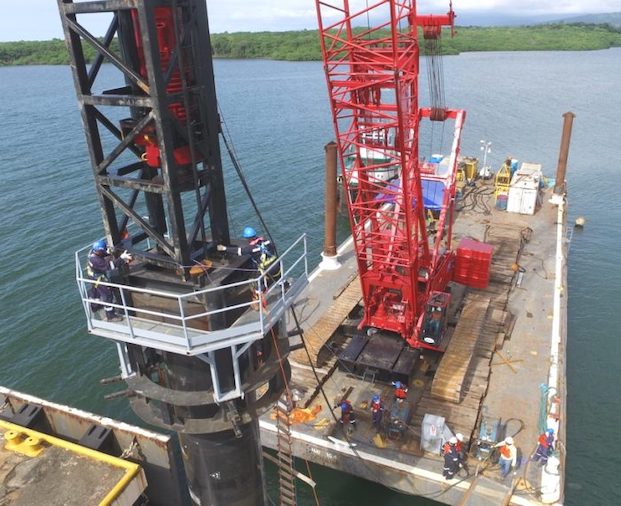
BSP - Hydraulic Drop Hammer - SL Type
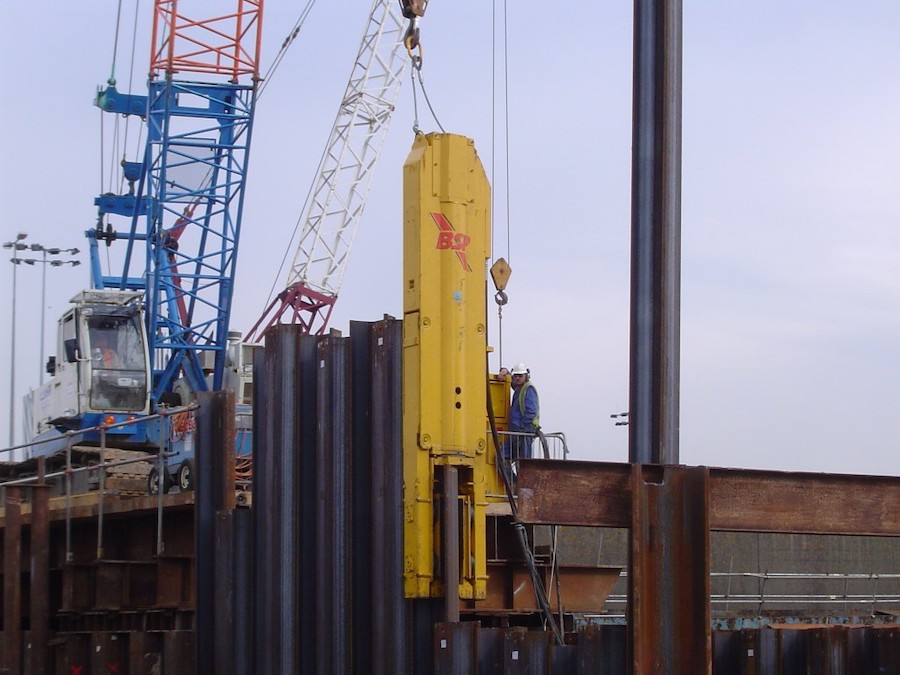
APE Model 15/60 Hydraulic Impact Hammer
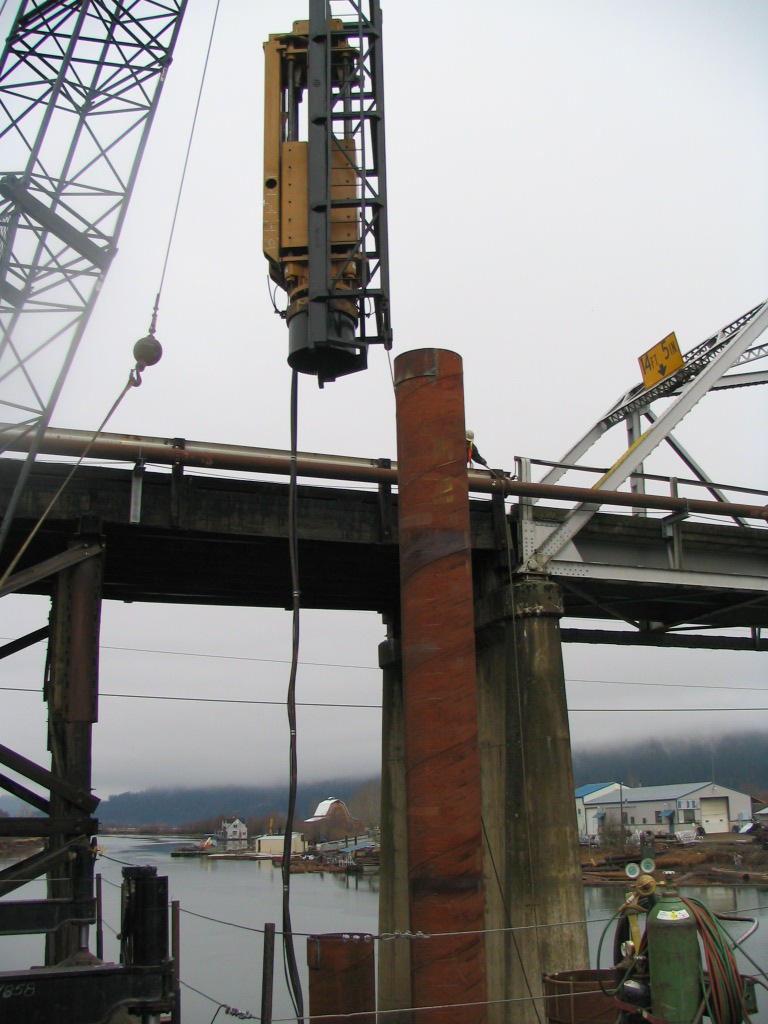
Junttan Hydraulic Impact Hammer HHK S-SERIES
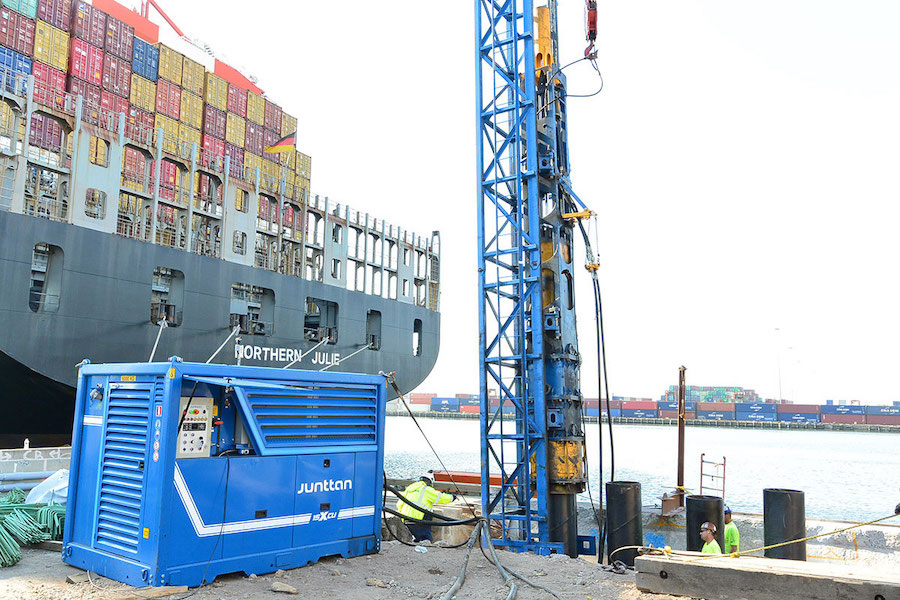
APE D25-32 Diesel Impact Hammer
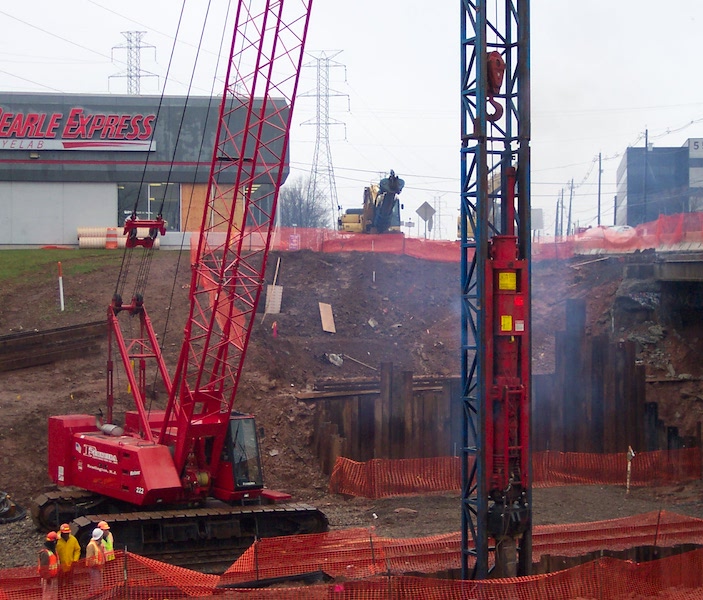
Driving Accessories
It is not possible for the striking end of the ram of an impact hammer to directly adapt itself to all shapes of piles. It is necessary to have driving accessories of various types and sizes inserted between the bottom of the hammer and the pile to both mate the two geometrically and transmit the impact hammer force to the pile.
Hammer Cushion
Most impact hammers have some type of cushion under the end of the ram to protect the hammer’s striking parts from damage.
Anvil
The rams of most external combustion hammers strike the hammer cushion or top plate directly. With internal combustion hammers, an anvil is necessary to trap the combustible mixture and allow it to build pressure.
Helmet
The helmet is the heavy and rigid steel block between hammer and pile. Often the hammer manufacturer supplies helmet inserts or adapters. The helmet distributes the blow from the hammer more uniformly to the head of the pile to minimize pile damage. It is important that the helmet’s striking surface is smooth and contacts the pile top evenly. It should not allow more than approximately 2 inches (50 mm) of lateral movement. The helmet weight (more properly mass) must be known to evaluate the drivability of a pile using the wave equation.
Pile Cushion
If the pile is in danger of being cracked in tension during driving, then pile cushions may be very thick (up to 18” (457 mm)). For the protection of the pile top against a compressive damage, thinner cushions are usually sufficient. The depth of these cushions can vary from 6” (152 mm) to 18” (457 mm).
Mandrel
A mandrel is used to install thin-wall shell piles, which are subsequently filled with concrete. The mandrel is necessary because the pile wall is too thin to withstand the stresses of driving.
Followers
A follower is a steel member placed between the pile hammer and pile that allows the pile to be driven below the reach of the leads. The most common uses are to drive a pile below the top of an existing structure or for driving piles over water.
SPS Cylinder Pile Cushions
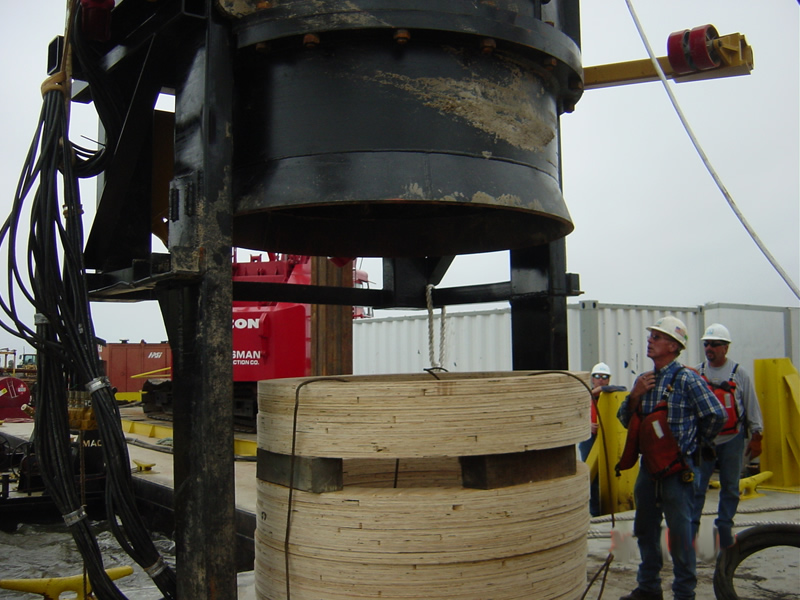
Pile Driving Helmet by Geoquip USA
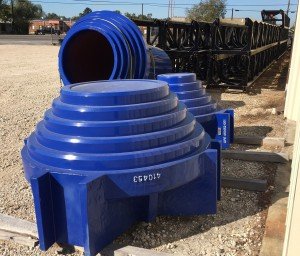
Vibratory Drivers
A vibratory pile driver is a machine that installs piling into the ground by applying a rapidly alternating force to the pile. This is generally accomplished by rotating eccentric weights about shafts. Each rotating eccentric produces forces acting in a single plane and directed toward the centerline of the shaft.
Types of Vibratory Hammers
Low-Frequency Hammers
These are vibratory hammers with a vibratory frequency of 5 to 10 Hz, used primarily with piles which have high mass and toe resistance such as concrete and large steel pipe piles.
Medium-Frequency Hammers
These are hammers with a vibratory frequency of 10 to 30 Hz, used for piling such as sheet piles and small pipe piles.
High-Frequency Hammers
These consist of all vibratory hammers that vibrate at frequencies greater than 30 Hz. There are of two basic types. The first machines are in the 30 to 40 Hz range that are designed primarily to minimize vibration of neighboring structures. The primary advantage of these machines is their lowered transmission of ground excitation to neighboring structures.
Sonic or Resonant Hammers
In a class by itself is the resonant pile driver, first introduced in the early 1960’s. The central principle of the resonant driver is to induce resonant response in the pile. This facilitates driving and extracting. The resonant driver operates at frequencies in the range of 90 to 120 Hz.
APE Dodecakong
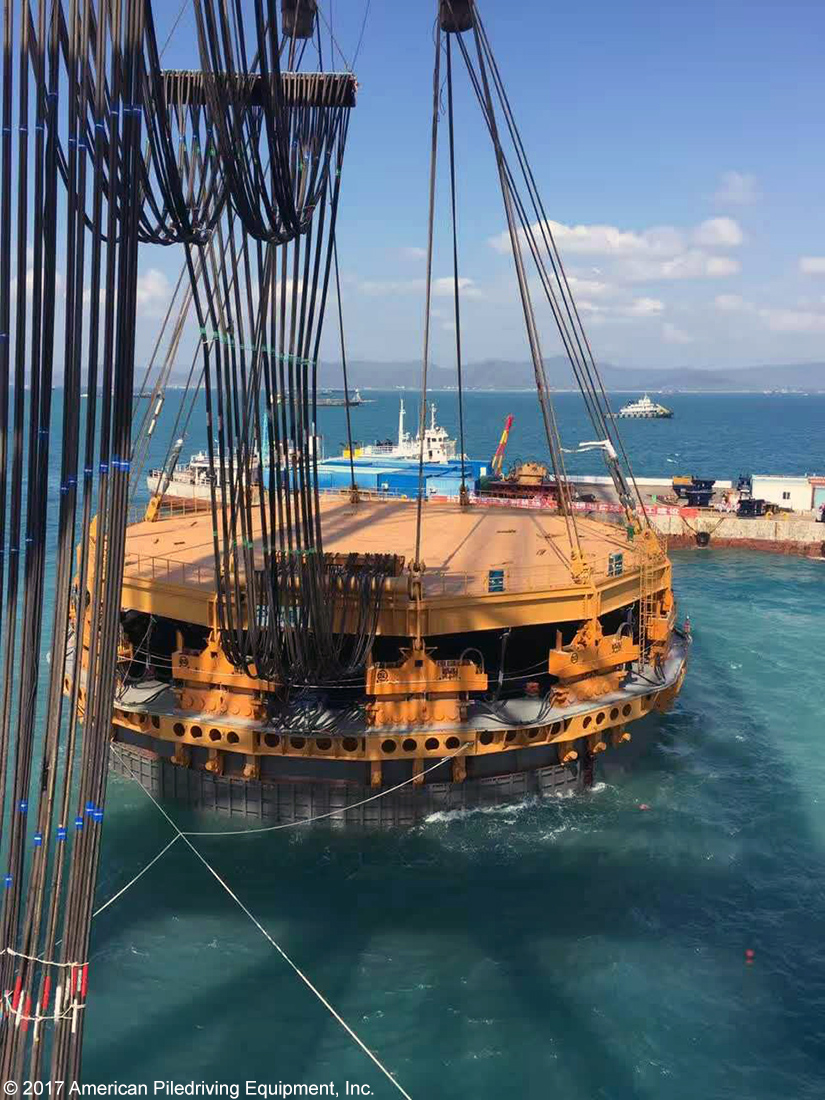
PILE BUCK’S TOP RECOMMENDED IMPACT HAMMERS AND VIBRATORY DRIVERS
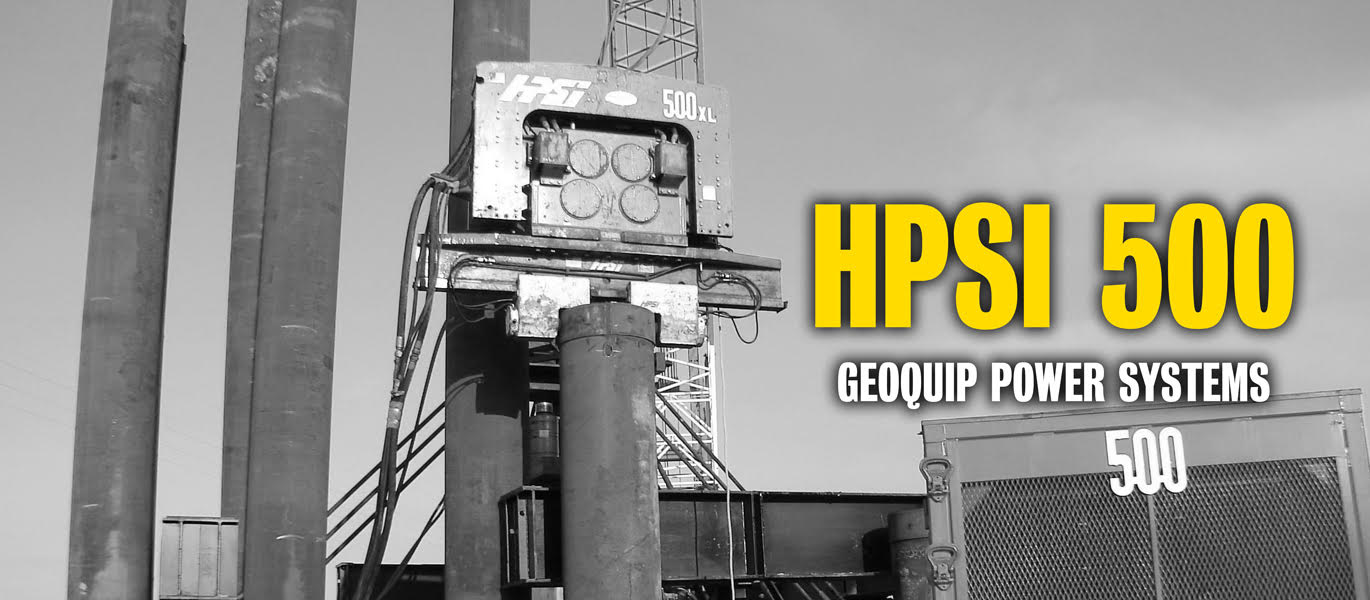
Description
Since 1980, HPSI has been designing and manufacturing the highest quality, most dependable, and longest-lasting vibratory hammers and hydraulic systems on the market. The HPSI Model 500 has proven itself to be the gold standard in the industry when it comes to delivering peak-performance at the pile without compromising on quality or reliability. The HPSI Model 500 is adaptable to any type of pile (pipe pile, steel sheet pile, h-pile, king pile, concrete piles, etc.) using a variety of specialized clamp attachments.
Technical Specs:
Eccentric Moment: 5,000 in. lbs.
Dynamic Force: 182 tons
Frequency: 1600 VPM (maintained under load)
Amplitude: 1.12 in
Pile Clamp Force: 200 tons
Maximum Line Pull: 75 tons
Suspended Weight: 22,500 lbs
Length: 102 in
Width: 14 in
Height: 102 in
GeoQuip Power Systems

Description
- Rifle-bored top plate delivers oil to motors without using hoses
- Patented one piece helical gear/eccentric eliminates gearbox failures caused by broken pins, keys, bolts or splines found in all other vibro gearboxes
- Giant double roller spherical bearings for super long life
- Center safety pin shows the line load on pile and cranes
Technical Specs
Eccentric Moment: 5,320 in-lbs (61 kgm)
Drive Force: 259 tons (2,300 kN)
Frequency (VPM): 0-1850 vpm
Max Line Pull: 133 tons (1,183 kN)
Bare Hammer Weight w/o Clamp: 16,850 lbs (7,643 kg)
Shipping Weight w/ 200’ Bundle: 23,700 lbs (10,751 kg)
Throat Width: 22” (56 cm)
Length: 126” (319 cm)
Height w/o Clamp: 81” (207 cm)
Power Unit Engine Type: CAT C18 TIER IV STAGE V DUAL CERTIFIED
Power Unit Horsepower: 800 HP (597 kW)
American Piledriving Equipment
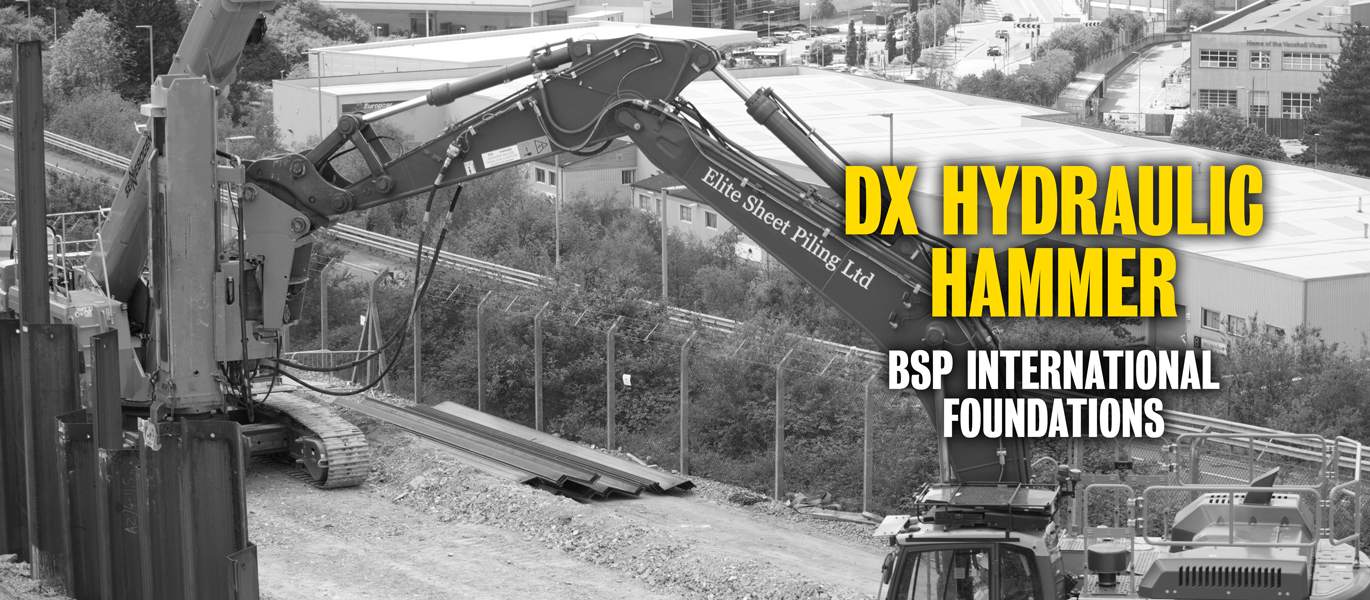
Description
Originally BSP designed and developed the DX hydraulic hammer range to meet the technical and equipment requirements of contractors engaged in installing equipment and maintaining the UK’s rail network. It was specifically developed to drive steel piles to support electrification staunchions, gantries and other railway projects requiring foundation piling. It has been designed as an attachment for mounting on road/rail or tracked excavators with an operating weight of around 32t or greater.
Technical Specs (DX30 model)
Overall length: 4300 mm
Hammer width: 500
Hammer mass: 5500 kg
BSP International Foundations
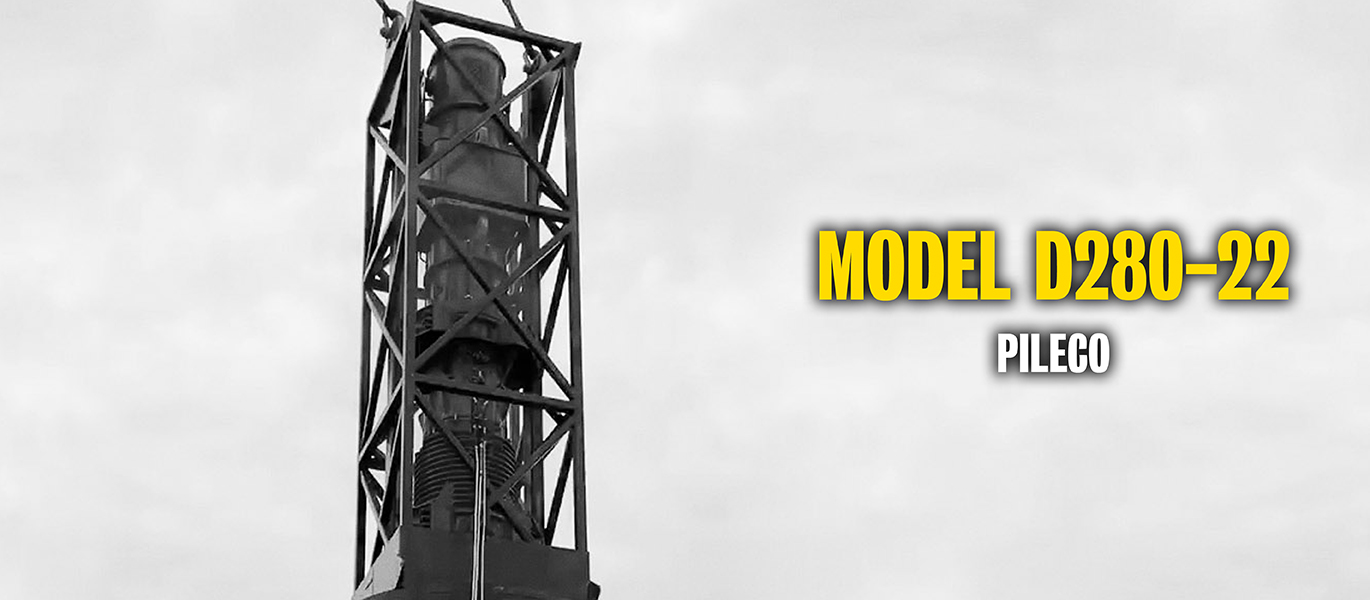
Description
D280-22 with its more than 688,000 ft lbs of energy is a beast of the Pileco fleet. This hammer is one of the largest in the industry with the ability to drive over 10ft in diameter piles. Matched with our 120” diameter offshore lead with interchangeable sleeves to fit different size pile will make this setup unmatched in the field.
Technical Specs
DIMENSIONS:
Hammer Length: 8832 mm (29′ ft)
Hammer Length w/starter guides: 9449 mm (31′ ft)
Outer diameter of impact block: 1189 mm (4′ ft)
Min. Guiding Width: 1737 mm (68″ in)
WEIGHT:
Weight of diesel pile hammer approx.: 113,538 lbs
Weight of piston approx.: 61,729 lbs
Impact Block approx.: 14,065 lbs
Tripping device approx.: 5,291 lbs
ENERGY PER BLOW:
Max: 935.9 kNm/ 688,145 ft lbs
Min: 486.7 kNm/ 357,835 ft lbs
Number of blows: 36–50 min
Pileco
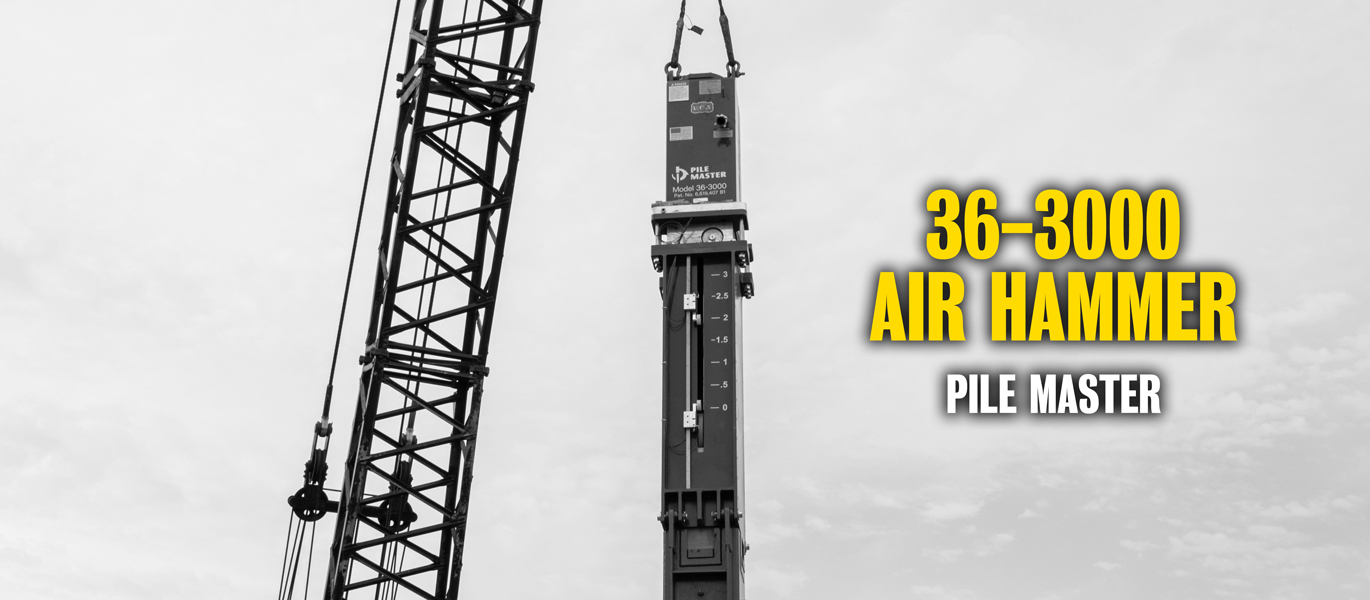
Description
The PDA-tested Pile Master 36-3000 Air Hammer is ideal for your next pile driving project. The second most powerful in its product line, this 6,200-pound hammer maximizes air usage by delivering up to 9,000-foot-pounds of energy with each blow. Pile Master Air Hammers – originally built for the dock building industry – are designed for driving timber, h-pile, pipe, and prestressed concrete piles. The 36-3000, like all Pile Master hammers, is known for efficiency. It can achieve up to 90 percent energy transfer into the pile with an air compressor as small as 250 CFM. The 36-3000 offers an adjustable stroke from 6 to 36 inches and a 3,000-pound ram. The hammer can be guided with 21- or 26-inch (53- or 66-centimeter) leads, or freely suspended with an extended base. An optional sheet pile adapter makes the 36-3000 an effective way to drive sheet piles in soil conditions where a vibratory hammer cannot achieve the required depth. Pile Master hammers are also environmentally friendly, using a biodegradable anti-freeze as the only lubricant.
Technical Specs
Maximum energy: 9,000 ft. lb.
Weight: 6,200 lb.
Air required: 250 CFM Minimum
Height: 1971 mm
Width: 388 mm
Pile Master
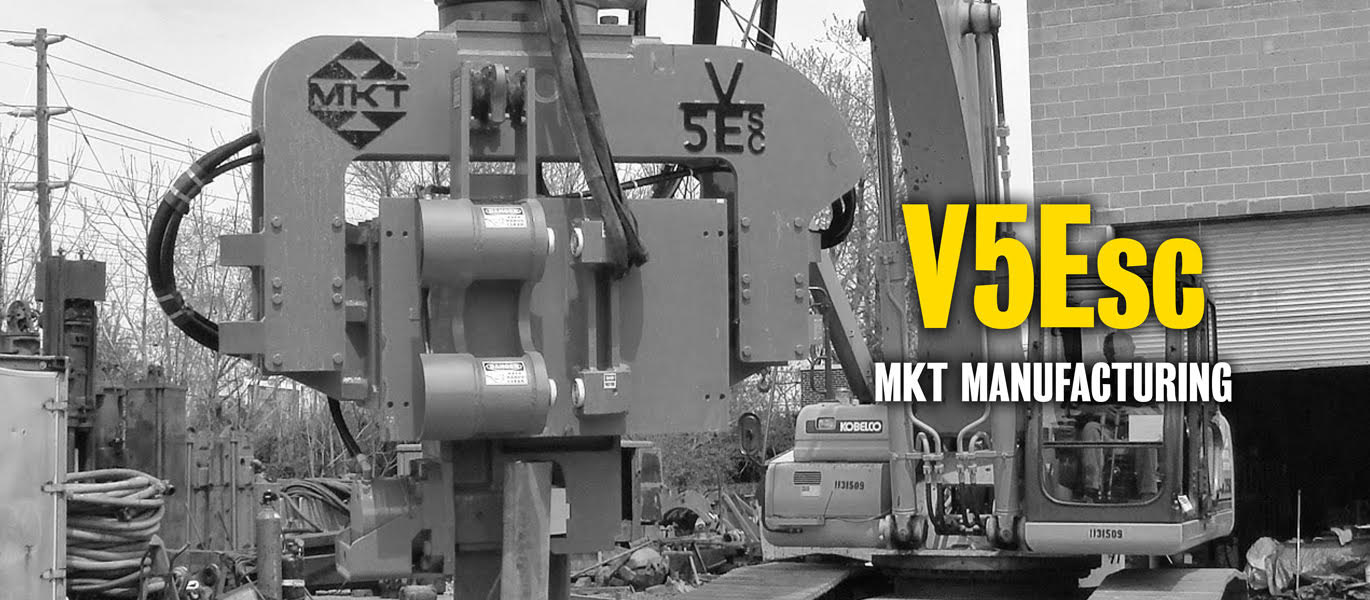
Description
MKT continues to be the leader in lifetime value and total cost performance with each of its Vibratory Pile Driver/Extractor systems. From the lightweight V-1 to the extra heavy-duty V-52 (201 tons of driving force), each MKT System provides outstanding driving and extracting performance for the many foundation construction scenarios that call for nonbearing piling. We offer the best combination of hydraulic horsepower, frequency and total weight.
Technical Specs
Driving Force: 53 tons (472kN)
Frequency: 1700 CPM
Eccentric Movement: 1300 in-lbs (1500 kg-cm)
Amplitude: 1 in (25.4 mm)
Clamping Force: 62 tons (550 kN)
Maximum Line Pull: 30 tons (267 kN)
Height: 75 in (1905 mm)
Throat Width: 13 in (330 mm)
Shipping Width: 85 in (2159 mm)
Weight w/ Standard Clamp: 6200 lbs (2813 kg)
Hose Bundle Length: 100 ft (30 m)
Hose Bundle Width: 830 lbs (378 kg)
MKT Manufacturing
Description
Our range of vibrodriver H/HD with standard frequency and fixed eccentric moment. This robust range adapts to applications needing to drive sheet piles and casings with total weights up to 150 tons which makes it the largest range of “Heavy Duty” Vibrodrivers in the world.
Technical Specs (50 HD model):
Eccentric Moment: 50 m.kg
Hydraulic Power: 304 kW / 413 HP
Oil Flow: 507 L/min
Max Frequency: 25 Hz / 1500 rpm
Max Centrifugal Force: 1258 kN
Max Line Pull Capacity: 625 kN
Vibrating Weight Without Clamp: 3060 kg
Total Weight Without Clamp: 5650 kg
Max Amplitude: 32.7 mm
Length: 2.500 m
Max Width: 0.910 m
Centre Width: 0.330 m
Height Without Clamp: 2.197 m
PTC Fayat Group
Description
The ABI Mobilram is an ideal machine for all common civil engineering works such as piling, extracting, augering, drilling and vibration-free piling installations. The heart of this system is a slewable ‘all-direction’ telescopic or fixed leader mast mounted to a special carrier. The leader mast serves as a guide for the attachments, and is available with stroke up to 82 feet. Smaller models also allow for easy transport and compact jo sites. Quick and safe set up from transport mode to working mode and back can be accomplished with ease utilizing the ABI docking system.
Further advantages of the ABI Mobilram include optimal stability with high working loads, self-propelled carrier with high engine power, low manpower requirements, and a variety of attachments. These include the ABI MRZV vibratory hammer, MDBA drilling attachment, TMBA twin and triple mix, VDW double head, Delmag diesel hammer, and HPZ pile press.
Technical Specs (50 HD model):
Carrier: Sennebogen SR 35 series F
Engine: 630 h.p. CAT C18 tier 4F diesel engine
Max mast torque absorption: 147,500 ft. lbs.
Axuiliary Winch: 11,240 lb f.
Vibratory attachment: MRZV 30VV
Stroke with MRZV 30VV attachment: 69 ft.
Optional ABI Customer Portal
Hammer and Steel Inc.
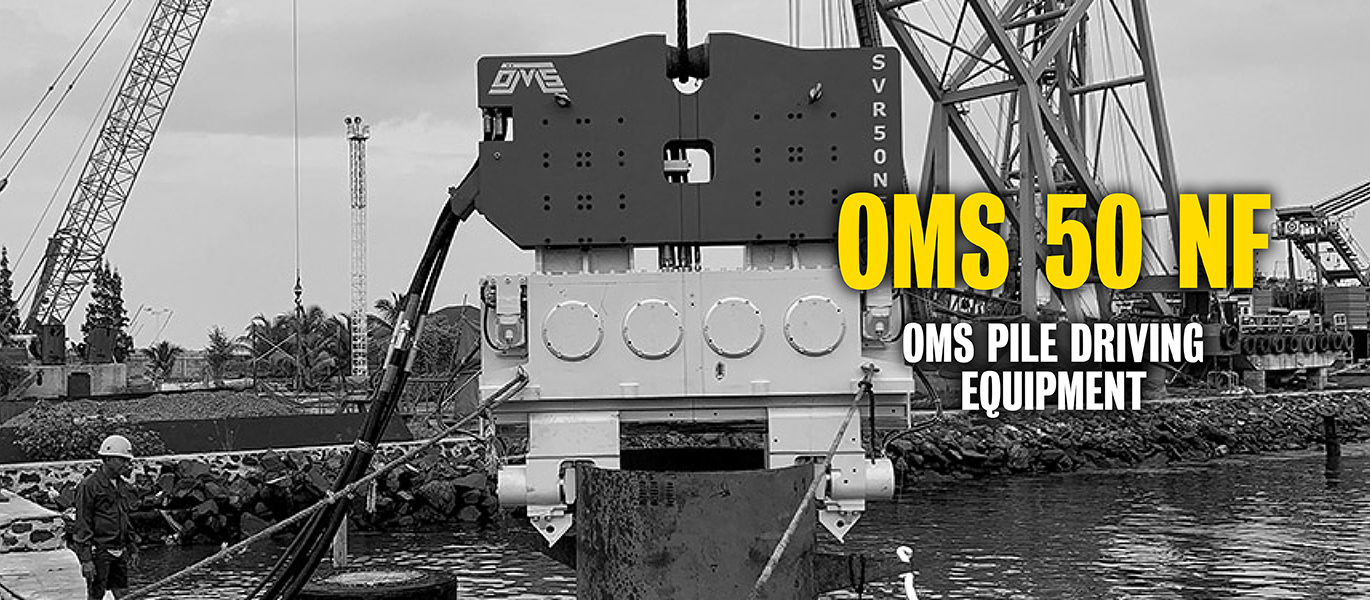
Manufacturer of Pile Driving Equipment for over 35 years!
OMS vibro hammer is a world brand in the production of vibratory pile driving equipment, with its products performing in all conditions around the globe. Established in 1987, OMS has mastered the design and manufacture of vibratory pile driving/extracting machines, hydraulic power packs, hydraulic clamps, and soil improvement equipment. The brand is produced with innovative and state of art technology. Today, OMS is among the companies leading this sector with the in-demand products.
Description
- High performance,
- Recommended in projects requiring a high driving or extracting force,
- Various clamp types to suit all pile types,
- High eccentric moment and vibration amplitude,
- Performance of desired power settings and work tracking by the control system,
- Innovative structure adapting to fast developing technology,
- 70% in-house production,
- We carry out the necessary tests and quality control in our factory,
- Full support for installation, maintenance and repair needs,
- Fast delivery and professional after sales team,
- Spare parts and training support.
Technical Specs:
Eccentric Moment: 50.2 kgm – 4357 in.lbs
Centrifugal Force (Max.): 1409 kN – 159 tons
Frequency: 1600 rpm
Oil Flow: 605 l/min – 160 gpm
Power: 352 kW – 472 hP
Amplitude: 24 mm – 0.9 in
Pulling Force (Max.): 706 kN – 80 tons
Pile Clamp Force: 1700 kN – 191 tons
Pipe Clamping Force: 1780 kN – 200 tons
Weight and Dimensions
Dynamic Weight W/O Clamp: 4130 kg – 9105 lbs
Total Weight W/O Clamp: 6150 kg – 13559 lbs
Length: 2848 mm – 112 in
Height: 2861 mm – 113 in
Width: 590 mm – 23 in
Throat Width: 360 mm – 14.2 in




